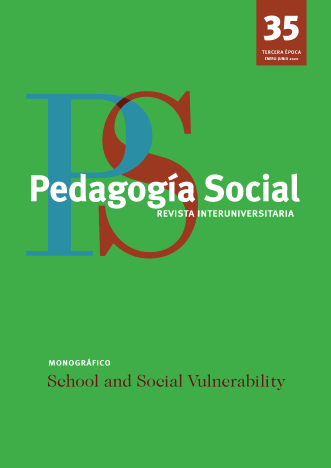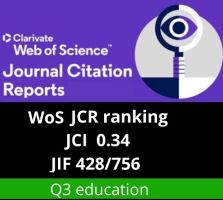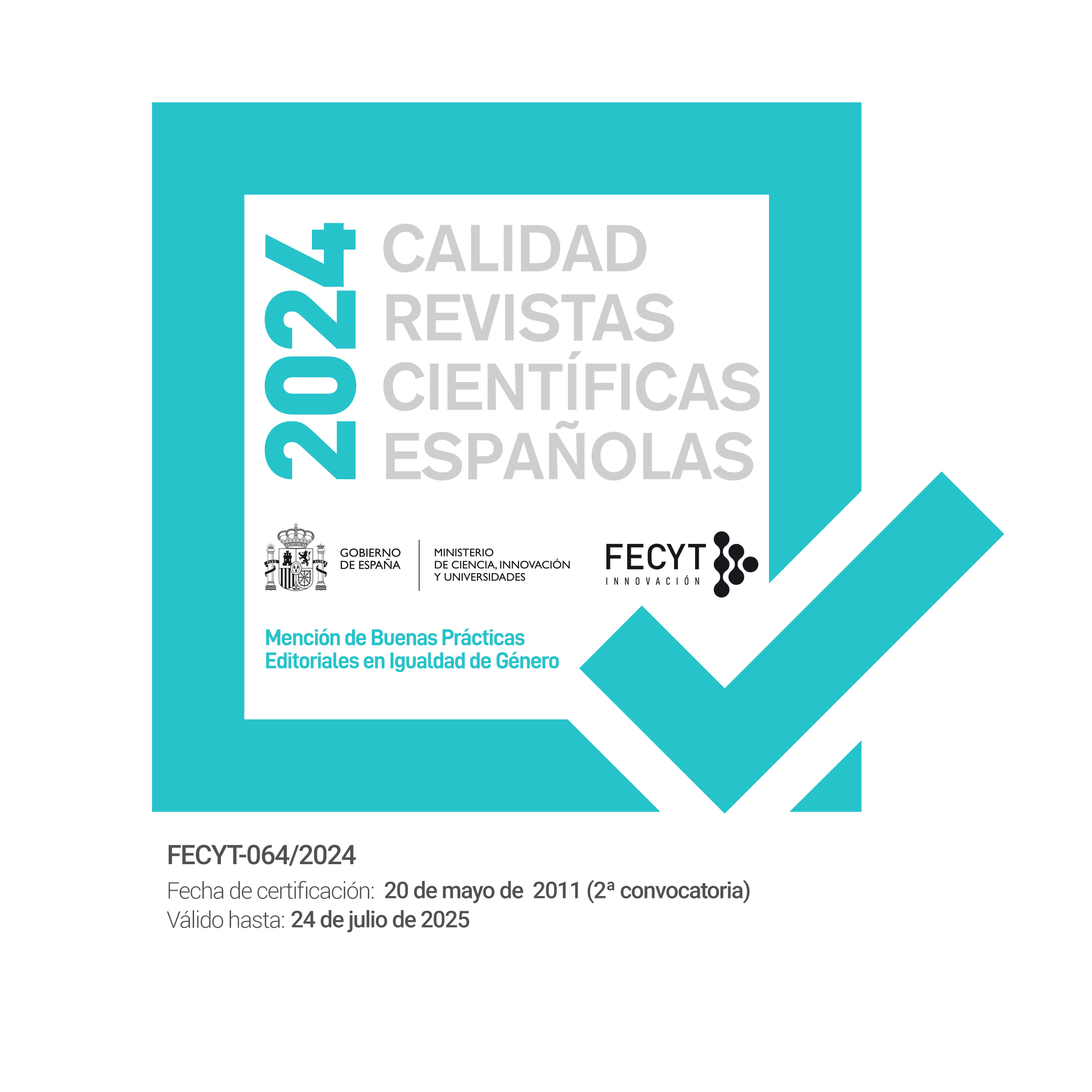Peer abuse in secondary education by gender and school year. The relationships with equals, school liking and satisfaction with life for bullies and victims
DOI:
https://doi.org/10.7179/PSRI_2020.35.03Keywords:
peer abuse, bullying, age differences by gender, victim, abuserAbstract
A review and an analysis of peer abuse and bullying in adolescents were carried out for the purposes of this piece of research. An assessment was made of the ways peer abuse can be presented during this stage of human development, as well as the differences according to gender and school year. Additionally, the potential association with other varia-bles was analysed such as school liking, the relationships with equals and the satisfaction of adolescents with life. The results were compared depending on whether the adolescent was a victim or a bully and the relationship between being a bully and being a victim was put under analysis. The study was carried out with 1,128 adolescents registered in the 1st and 4th years of obligatory secondary school (average age: 14.4 years old). 13% of the respondents stated that they had been bullied some time and 21.2% stated they had taken part in an episode of bullying. There is more bullying in the 1st year of obligatory secondary education than in the 4th year. The most frequent form of bullying was verbal (28.5%); followed by spreading lies and rumours with the intention of harming others (27.4%), which was more frequent amongst girls; social bullying (ignoring or excluding others) is suffered by 18.4% of the respondents with no gender difference; physical bullying is suffered by 7.7% and mostly amongst boys. Bullies and victims, compared to others, feel unhappier and think their moment in life is worse than others. Bullies feel less accepted and more disliked by others. Victims like school less than others. The differences with other papers are discussed hereA review and an analysis of peer abuse and bullying in adolescents were carried out for the purposes of this piece of research. An assessment was made of the ways peer abuse can be presented during this stage of human development, as well as the differences according to gender and school year. Additionally, the potential association with other variables was analysed such as school liking, the relationships with equals and the satisfaction of adolescents with life. The results were compared depending on whether the adolescent was a victim or a bully and the relationship between being a bully and being a victim was put under analysis. The study was carried out with 1,128 adolescents registered in the 1st and 4th years of obligatory secondary school (average age: 14.4 years old). 13% of the respondents stated that they had been bullied some time and 21.2% stated they had taken part in an episode of bullying. There is more bullying in the 1st year of obligatory secondary education than in the 4th year. The most frequent form of bullying was verbal (28.5%); followed by spreading lies and rumours with the intention of harming others (27.4%), which was more frequent amongst girls; social bullying (ignoring or excluding others) is suffered by 18.4% of the respondents with no gender difference; physical bullying is suffered by 7.7% and mostly amongst boys. Bullies and victims, compared to others, feel unhappier and think their moment in life is worse than others. Bullies feel less accepted and more disliked by others. Victims like school less than others. The differences with other papers are discussed here
Downloads
References
Álvarez, D., Dobarro, A., Rodríguez, C., Núñez, J.C., & Álvarez, L. (2013). El consenso de normas de aula y su relación con bajos niveles de violencia escolar. Infancia y Aprendizaje, 36(2), 199-2018. doi:10.1174/021037013806196229.
Bender, D., & Lösel, F. (2011). Bullying at school as a predictor of delinquency, violence and other anti-social behavior in adulthood. Criminal Behaviour and Mental Health, 21, 99-106.
Brixval, C.S., Rayce, S.L.B., Rasmussen, M., Holstein, B.E., & Due, P. (2012). Overweight, body image and bullying. An epi¬demiological study of 11- to 15-years old. European Journal of Public Health, 22(1), 126-130. doi:10.1093/eurpub/ckr010.
Cantril, H. (1965). The pattern of human concern. New Brunswick, New Jersey: Rutgers University Press.
Cánovas, P., Riquelme, V., Orellana, N., & Sáez, B. (2019). Víctimas invisibles: Análisis de la intervención socioeducativa de niñas y niños expuestos a violencia de género en la familia. Pedagogía social, 34, 113-127. doi:10.7179/PSRI_2019.34.08.
Cerezo, F. (2001). Variables de personalidad asociadas en la dinámica bullying (agresores versus víctimas) en niños y niñas de 10 a 15 años. Anales de Psicología, 17(1), 37-43.
Chester, K.L., Callaghan, M., Cosma, A., Donnelly, P., Craig, W., Walsh, S., & Molcho, M. (2015). Cross-national time trends in bullying victimization in 33 countries among children aged 11, 13 and 15 from 2002 to 2010. European Jour¬nal of Public Health, 25(2), 61-64. doi:10.1093/eurpub/ckv029.
Conde, S., & Ávila, J.A. (2018) Influencia de los observadores sobre la agresión y el sentimiento de maltrato escolar. Psychology, Society & Education, 10(2), 173-187. doi:10.25115/psye.v10i2.1021.
Cook, C.R., Williams, K.R., Guerra, N.G., Kim, T.E., & Sadek, S. (2010). Predictors of bullying and victimization in childhood and adolescence: A meta-analytic investigation. School Psychology Quarterly, 25(2), 65-83. doi:10.1037/a0020149.
Craig, W., Harel, Y., Fogel, H., Dostaler, S., Hetland, J., Simons, B.,… Pickett, W. (2009). A cross-national profile of bullying and victimization among adolescents in 40 countries. International Journal of Public Health, 54, 216-224. doi:10.1007/ s00038-009-5413-9.
Defensor del Pueblo & UNICEF. (2007). Violencia escolar: el maltrato entre iguales en la Educación Secundaria Obli¬gatoria 1999-2006. Madrid: Publicaciones de la Oficina del Defensor del Pueblo.
Del Rey, R., & Ortega, R. (2007). Violencia escolar: claves para comprenderla y afrontarla. Escuela abierta, 10, 77-89.
Durlak, J.A., Weissberg, R.P., Dymnicki, A., Taylor, R.D., & Schellinger, K.B. (2011). The impact of enhancing students’ social and emotional learning: meta-analysis of school-based universal interventions. Child Development, 82, 405-432. doi:10.1111/j.1467-8624.2010.01564.x.
Elgar, F.J., Mckinnon, B., Walsh, S. D., Freeman, J., Donnelly, P.D., Gaspar, M., ... Currie, C. (2015). Structural deter-minants of youth bullying and fighting in 79 countries. Journal of Adolescent Health, 57(6), 643-650. doi:10.1016/j. jadohealth.2015.08.007.
Elipe, P., Mora, J.A., Ortega, R., & Casas, J.A. (2015). Perceived emotional intelligence as a moderator variable between cybervictimization and its emotional impact. Frontiers in Psychology, 6, 486. doi:10.3389/fpsyg.2015.00486.
Estell, D., Farmer, T., Irvin, M., Crowther, A., Akos, P., & Boudah, D. (2009). Students with exceptionalities and the peer group context of bullying and victimization in late elementary school. Journal of Child and Family Studies, (18)2, 136–150. doi:10.1007/s10826-008-9214-1.
Estévez , E., Estévez, J.F., Segura, L., & Suárez, C. (2019). The Influence of Bullying and Cyberbullying in the Psycholog¬ical Adjustment of Victims and Aggressors in Adolescence. International Journal of Environmental Research and Public Health, 16, 1-16. doi:10.3390/ijerph16122080.
Etxeberría, F., & Elosegui, K. (2010). Integración del alumnado inmigrante: obstáculos y propuestas. Revista Española de Educación Comparada, 16, 235-263.
Fernández, P., Cabello, R., & Gutiérrez, M.J. (2017). Avances en la investigación sobre competencias emocionales en educación. Revista Interuniversitaria de Formación del Profesorado, 88, 15-26.
Fu, Q., Land, K.C., & Lamb, V.L. (2013). Bullying victimization, socioeconomic status and behavioral characteristics of 12th graders in the United States, 1989 to 2009: Repetitive trends and persistent risk differentials. Child Indicators Research, 6(1), 1-21. doi:10.1007/s12187-012-9152-8.
Fuentes, M.C., García, F., Gracia, E. & Lila, M. (2011). Autoconcepto y ajuste psicosocial en la adolescencia Psicothema, 23(1), 7-12.
Gil Villa, F. (2016). La sociedad vulnerable. Para una ciudadanía consciente y crítica con la desigualdad e inseguridad sociales. Madrid: Tecnos.
González, F., & De Castro, R.M. (2019). Mejorar la convivencia. Educación en valores y Derecho Educativo. Valencia: Tirant Lo Blanch.
González, F. & Escudero, J. (2018), El acoso escolar, bullying y ciberbullying. Formación, prevención y seguridad. Valen¬cia: Tirant Lo Blanch.
Guevara, R.M., & Urchaga, J.D. (2018a). Satisfacción vital y relaciones familiares y con iguales en la adolescencia. Cau¬riensia, 13, 243-258. doi: 10.17398/2340-4256.13.243.
Guevara, R.M. & Urchaga, J.D. (2018b). Percepción de la convivencia en el aula de Educación Secundaria: diferencias según sexo y curso escolar. En J.C. Torrego, L. Rayón, Y. Muñoz & P. Gómez (Eds.), Inclusión y mejora educativa (pp. 723-729). Alcalá de Henares: Universidad de Alcalá.
Heineman, P.P. (1972). Mobbning-Gruppvåld bland barn och vuxna. Estocolmo: Natur & Kultur.
Hoglund, W.L., & Leadbeater, B.J. (2007). Managing threat: Do social-cognitive processes mediate the link between peer victimization and adjustment problems in early adolescence? Journal of Research on Adolescence, 17(3), 525- 540. doi:10.1111/j.1532-7795.2007.00533.x.
Leria, F.J., & Salgado, J.A. (2019). Efecto del clima social escolar en la satisfacción con la vida en estudiantes de primaria y secundaria. Revista Educación, 43(1). 364-379. doi:10.15517/REVEDU.V43I1.30019.
Magaz, A.M. (2012). El maltrato entre iguales (bullying): Epidemiología y características psicológicas y sociodemográfi¬cas (Tesis doctoral inédita). Universidad Nacional de Educación a Distancia, Madrid.
Magaz, A.M., Chorot, P., Sandín, B., Santed, M. A., & Valiente, R.M. (2011). Estilos de apego y acoso entre iguales (bull¬ying) en adolescentes. Revista de Psicopatología y Psicología Clínica, 16, 207-221.
Magaz, A.M., Chorot, P., Santed, M.A. Valiente, R.M., & Sandín, B. (2016). Evaluación del bullying como victimización: Es¬tructura, fiabilidad y validez del Cuestionario de Acoso entre Iguales (CAI). Revista de Psicopatología y Psicología Clínica, 21, 77-95. doi:10.5944/rppc.vol.21.num.2.2016.16990.
Mateu, O., Piqueras, J.A., Rivera, Espada, J.O., & Orgilés, M. (2014). Aceptación /rechazo social infantil: relación con problemas emociones e inteligencia emocional. Avances en Psicología, 22(2), 205-213.
Miranda, R., Oriol, X., Amutio, A., & Ortúzar, H. (2019) Bullying en la adolescencia y satisfacción con la vida: ¿puede el apoyo de los adultos de la familia y de la escuela mitigar este efecto? Revista de Psicodidáctica, 24(1), 39-45. doi:10.1016/j.psicod.2018.07.001.
Molcho, M., Craig, W., Due, P., Pickett, W., Harel, Y., & Overpeck, M. (2009). HBSC Bullying Writing Group. Cross-na¬tional time trends in bullying behaviour 1994-2006: findings from Europe and North America. International Journal of Public Health, 54(2), 225-34. doi:10.1007/s00038-009-5414-8.
Moreno, C., Ramos, P., Rivera, F., García-Moya, I., Jiménez-Iglesias, A., Sánchez-Queija, I., & Moreno-Maldonado, C. (2014). Cuestionario HBSC. Madrid: Ministerio de Sanidad, Servicios Sociales e Igualdad.
Moreno, C., Ramos, P., Rivera, F., Jiménez, A., García, I., Sánchez, I., … Morgan, A (2016). Los adolescentes españoles: estilos de vida, salud, ajuste psicológico y relaciones en sus contextos de desarrollo. Resultados del Estudio HBSC- 2014 en España. Madrid: Ministerio de Sanidad, Servicios Sociales e Igualdad.
Musalem, B.R., & Castro, O.P. (2015). Qué se sabe de bullying. Revista de Medicina Clínica Condes, 26(1), 14-23.
Navarro, R., Larrañaga, E., & Yubero, S. (2011). Bullying-victimization problems and aggressive tendencies in spanish sec¬ondary schools students: the role of gender stereotypical traits. Social Psychology of Education:an International Journal, 14(4), 457-473. doi: http://dx.doi.org/10.1007/s11218-011-9163-1.
Navarro, R., Ruiz-Oliva, R., Larrañaga, E., & Yubero, S. (2015). The impact cyberbullying ando social life satisfaction among 10-12 year-old schoolchildren. Applied Research in Quality of Life, 10(1), 15-36. http://dx.doi.org/10.1007/ s11482-013-9292-O13-9292-O.
Nocito, G. (2017). Investigaciones sobre el acoso escolar en España: implicaciones psicoeducativas. Revista Española de Orientación y Psicopedagogía, 28(1), 104-118.
Olweus, D. (1996). The Revised Olweus Bully/Victim Questionnaire. Mimeo. Bergen, Norway: Research Center for Health Promotion, University of Bergen.
Olweus, D. (1973). Hackkycklingar och översittare. Forskning om skolmobning. Estocolmo: Almquist & Wiksell.
OMS. (2002). World report on violence and health. Informe mundial sobre la violencia y la salud. Recuperado de: http:// iris.paho.org/xmlui/handle/123456789/725.
Orpinas, P., & Horne, A.M. (2006). Bullying prevention: Creating a positive school climate and developing social com¬petence. Washington, D.C.: American Psychological Association.
Ortega, R., Elipe, P., Mora, J.A., Genta. M.L., Brighi, A., Guarini, A., Smith, P.K., Thompson, F., & Tippet, N. (2012). The emotional impact of bullying and cyberbullying on victims: a European cross-national study. Aggressive Behavior, 38(5), 342-356. doi: 10.1002/ab.2144.
Pedreira, P., Cuesta, B., & Bonet, C. (2011). Acoso escolar. Pediatría Atención Primaria, 13(52), 661-670.
Romero, M., Cuevas, M. C., Ferney, C., & Sierra, J. (2018). Diferencias por sexo en la intimidación escolary la resiliencia en adolescentes. Psicología escolar e educacional, 22(3), 519-526.
Salmivalli, C. (2010). Bullying and the peer group: A review. Aggression and Violent Behavior, 15, 112-120.
Sánchez, V., Ortega, R. & Menesini, E. (2012). La competencia emocional de agresores y víctimas en bullying. Anales de Psicología, 28(1), 71-82.
Save the Children. (2016a). Informe “Yo a eso no juego”. Retrieved from https://www.savethechildren.es/sites/default/ files/imce/docs/yo_a_eso_no_juego.pdf.
Save the Children. (2016b). Acoso escolar y ciberacoso: propuesta para la acción. Madrid: Ministerio de Sanidad, Ser¬vicios Sociales e Igualdad. Retrieved from https://www.savethechildren.es/sites/default/files/imce/docs/acoso_es¬colar_y_ciberacoso_informe_vok_-_05.14.pdf.
Shetgiri, R. (2013). Bullying and victimization among children. Advances in Pediatrics, 60(1), 33-51. doi:10.1016/j. yapd.2013.04.004.
Solberg, M., & Olweus, D. (2003). Prevalence estimation of school bullying with the Olweus Bully/Victim Questionnaire. Aggressive Behaviour, 29, 239-268.
Ttofi, M.M., & Farrington, D.P. (2008). Short-term and long-term effects of bullying and the importance of Defiance Theory in explanation and prevention. Victims and Offenders 3, 289-317.
Ttofi, M.M., Farrington, D.P. & Lösel, F. (2011). Health consequences of school bullying. Journal of Aggression, Conflict and Peace Research, 3(2), 60-62.
Undheim, A.M., & Sund, A.M. (2010). Prevalence of bullying and aggressive behavior and their relationship to mental health problems among 12 to 15-year-old Norwegian adolescents. European Child & Adolescent Psychiatry, 19, 803- 811. doi:10.1007/s00787-010-0131.
Urchaga, J.D., Carballa, N., Barahona, N., & González, F. (2018). Cyberbullying nas redes sociais entre os alunos adoles¬centes da Costa Rica. En L.M. Duso, J. Wruck, D. Pulcherio (eds), VI congresso internacional e i congresso nacional de investigação em direito investigativo e o xiii ciclo de estudos jurídicos (pp. 391-399). Frederico Westphalen (Bra¬sil). URL.
Valois, R., Kerr, J.C. & Huebner, S.E. (2012). Peer victimization and perceived life satisfaction among early adolescents in the United States. American Journal of Health Education, 43(5), 258-268. doi:10.1080/19325037.2012.10599244.
Zych, I., Beltrán-Catalán, M., Ortega-Ruiz, R., & LLorent, V.J. (2018). Competencias sociales y emocionales de ado-lescentes involucrados en diferentes roles de bullying y cyberbullying. Revista de Psicodidáctica, 23(2), 86-93. doi:10.1016/j.psicod.2017.12.001.
Zych, I., Ortega-Ruiz, R., & Marín-López, I. (2018). Dimensions and psychometric properties of the social and emotion¬al competencies questionnaire in youth and adolescents. Revista lationamericana de Psicología, 50(2), 98-106. doi:10.14349/rlp.2018.v50.n2.3.
Downloads
Published
How to Cite
Issue
Section
License
Copyright (c) 2020 Pedagogía Social. Revista Interuniversitaria

This work is licensed under a Creative Commons Attribution-NonCommercial-ShareAlike 4.0 International License.
Copyright and right to archive
The published version of the articles can be self-archived by their authors in open access institutional and thematic repositories. However, Pedagogía Social. Revista Interuniversitaria must authorize partial or global reutilisation on new papers or publications.
Published papers must be cited including the title of the journal Pedagogía Social. Revista Interuniversitaria, issue, pages and year of publication
Ethical responsibilities
Pedagogía Social. Revista Interuniversitaria does not accept any material that has been previously published in other documents or publications. Authors are responsible for obtaining the required permissions for partial or global reproduction any material from other publications, and to correctly quote its origin.
Pedagogía Social. Revista Interuniversitaria is obliged to detect and report fraudulent practices.
Only those who have intellectually contribute to the development of the paper must appear as authors.
The journal expects authors to declare any commercial partnership that might entail a conflict of interest with respect to the submitted article.
Authors must mention in the article, preferably in the “methodology” section, that the procedures used during the samplings and controls have been made after getting informed consent.
The journal will not use any received contribution in a way other than the goals described in these guidelines.
Copyright Notice
© Pedagogía Social. Revista Interuniversitaria. Papers published in both the printed and online versions of this Journal are property of Pedagogia Social. Revista Interuniversitaria, being required to cite the source in any partial or total reproduction.
Unless otherwise stated, all content of this electronic journal is distributed under "Creative Commons Attribution-Non commercial 3.0 Spain" (CC-by-nc) license for use and distribution. The informative version and the legal text of this license is available here. This has to be expressly stated in this way when necessary.






